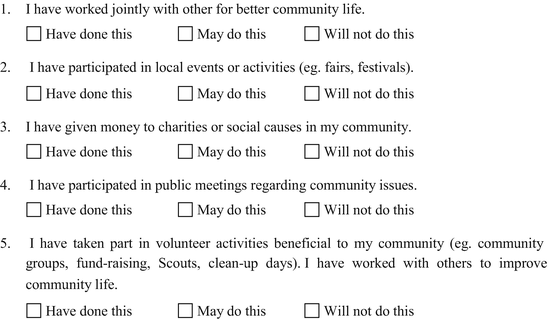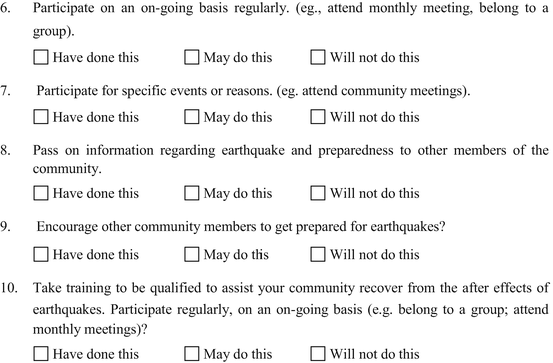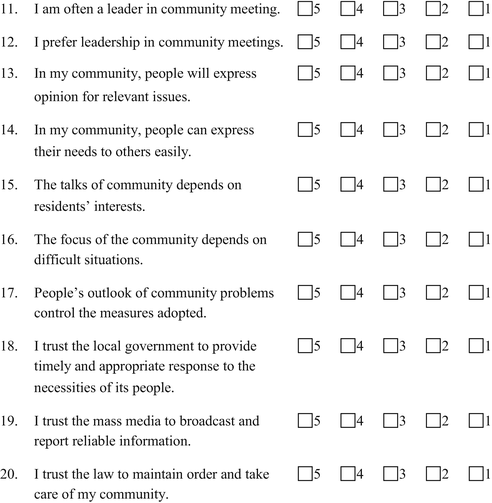Abstract
This chapter presents the development of a survey based tool specific to India, to assess the earthquake preparedness level of individual, families and communities residing in earthquake prone regions.
Know Your Readiness Index and Boost Preparedness Level
References
Ardalan, A., & Sohrabizadeh, S. (2016). Assessing households preparedness for earthquakes: An exploratory study in the development of a valid and reliable Persian-Version Tool. PLOS Current. doi:10.1371/currents.dis.ccc8697279713e66887b928b839d0920.
Baytiyeh, H. (2014). The assessment of earthquake preparatory knowledge and activities of Lebanese engineering students. Proceedings of American Society for Engineering Education Annual Conference and Exposition, 14, 11978–11987.
Becker, J. S. (2010) Understanding disaster preparedness and resilience in Canterbury: Results of interviews, focus groups and a questionnaire survey. GNS Science Report.
Becker, J. S., Paton, D., Johnston, M. D., & Ronan, K. R. (2012). A model of household preparedness for earthquakes: How individuals make meaning of earthquake information and how this influences preparedness. Natural Hazards, 64, 107–137.
De Man, A., & Simpson-Housley, P. (1987). Factors in the perception of earthquake hazard. Perceptual and Motor Skills, 64, 815–820.
Dooley, D., Catalano, R., Mishra, S., & Serxner, S. (1992). Earthquake preparedness: Predictors in a community survey. Journal of Applied Social Psychology, 22, 451–470.
Edwards, M. E. (1993). Social location and self-protective behavior: Implications for earthquake preparedness. International Journal of Mass Emergencies Disasters, 11, 293–303.
Farley, J. E., Barlow, H. D., Finklestein, M. S., & Riley, L. (1993). Earthquake hysteria, before and after: A survey and follow-up on public response to the Browning forecast. International Journal of Mass Emergencies Disasters, 11, 305–322.
Hirose, H. (1986). The psychological impact of the Tokai earthquake prediction: Individual’s responses and the mass media coverage. Japanese Psychological Research, 26, 64–76.
Hirose, H., & Ishizuka, T. (1983). Causal analysis of earthquake concern and preparing behavior in the North Izu Peninsula. Japanese Psychological Research, 25, 103–111.
Hurnen, F., & McClure, J. (1997). The effect of increased earthquake knowledge on perceived preventability of earthquake damage. Australasian Journal of Disaster and Trauma Studies, 3, 1–14.
Jackson, E. L. (1981). Response to earthquake hazard: The West Coast of North America, Environmental. Behaviour, 14, 387–416.
Jackson, E. L., & Mukerjee, T. (1974). Human adjustment to the earthquake hazard in San Francisco, California. In G. F. White (Ed.), Natural hazards: Local national and global (pp. 160–166). New York: Oxford University Press.
Kiecolt, K. J., & Nigg, J. M. (1982). Mobility and perceptions of a hazardous environment. Environmental Behaviour, 14, 131–154.
McClure, J., & Allen, W. (2001). When earthquake damage is seen as preventable: Attributions, locus of control and attitudes to risk. Basic and Applied Social Psychology, 23(2), 109–121.
McClure, J., Fischer, R., Hunt, M., & Charleson, A. (2007). Using action plans to increase voluntary actions that reduce earthquake damage. EQC Report No. 2314, Earthquake Commission, Wellington, New Zealand.
McClure, J., Sibley, C. G., & White, J. (2009). Framing effects on preparation intentions: Distinguishing actions and outcomes. Disaster Prevention and Management, 18(2), 187–199.
Mileti, D., & O’Brien, P. W. (1992). Warnings during disasters: Normalizing communicating risk’. Social Problems, 38, 40–57.
Mulilis, J. P., Duval, T. S., & Bovalino, K. (1990). Tornado preparedness of students, nonstudent renters, and non-student owners: Issues of PrE theory. Journal of Applied Social Psychology, 30, 1310–1329.
Mulilis, J. P., & Lippa, R. (1990). Behavioral change in earthquake preparedness due to negative threat appeals: A test of protection motivation theory. Journal of Applied Social Psychology, 20, 619–638.
Okazaki, K., Ilki, A., Ahmad, N., Kandel, R.C., & Rahayu, H. (2008). Seismic risk perception of people for safer housing. Proceedings of the 14th World Conference on Earthquake Engineering.
Paton, D., Bajek, R., Okada, N., & McIvor, D. (2010). Predicting community earthquake preparedness: A cross-cultural comparison of Japan and New Zealand. Natural Hazards, 54, 765–781.
Russell, L. A., & Bourque, L. B. (1995). Preparedness and hazard mitigation actions before and after two earthquakes. Environment and Behavior, 27, 744–770.
Spittal, M. J., Mc Clure, J., Siegert, R. J., & Walkey, F. H. (2008). Predictors of two types of earthquake preparation: Survival activities and mitigation activities. Environment and Behavior, 40(6), 798–817.
Sullivan, R., Mustart, D. A., & Galehouse, J. S. (1977). Living in earthquake country. California Geology, 3, 3–8.
Turner, R. H., Nigg, J. M., & Paz, D. H. (1986). Waiting for disaster: Earthquake watch in California. Los Angeles: University of California Press.
Yang S., Gao H., Liu, L., Tang, W., He, L., & Fan, C. (2010). Analysis on public earthquake risk perception: Based on questionnaire. Proceedings of 3rd International Conference on Cartography and GIS, Nessebar, Bulgaria.
Author information
Authors and Affiliations
Appendix: Questionnaire for Earthquake Readiness Indices
Appendix: Questionnaire for Earthquake Readiness Indices
4.1.1 Earthquake Readiness Index for Individuals
The following are the things that can be done to minimize the damage and disruption if an earthquake occurs. Record your responses (one response per statement)
How to calculate your score at individual level:
-
i.
Mark your responses against each statement.
-
ii.
Count the total number of responses against the first option (Have done this) for statements 1–25 or 27 (depending on employment status). This gives your ERI score.
-
iii.
The table provided at the end of the questionnaire gives your preparedness category.


If employed/studying, mark the following,

4.1.2 Earthquake Readiness Index for Community
Note: Community refers to a group in which you belong. It could be your neighbourhood, locality or social groups.
-
A.
With regard to your life in the community, record your responses. (Questions 1-5). (One response per statement)
How to calculate your score at community level:
-
i.
Mark your responses against each statement.
-
ii.
Count the total number of responses against the 1st option (Have done this) for statements 1 to 10.
-
iii.
Count the total number of responses against 1st (5) and 2nd (4) options for statements 11-20.
-
iv.
Sum of ii and iii gives the ERI score at community level.
-
v.
The table provided at the end of the questionnaire gives your preparedness category.

-
B.
With regard to preparedness point of view, record your responses. (Questions 6-10). (One response per statement)

-
C.
In regard to your general feelings about living in this community, please record to which extent you agree or disagree with the following statements on a scale of 1-5 (5- Strongly agree, 4- agree, 3- neither agree nor disagree, 2- disagree , 1- Strongly disagree) (Questions 11-20).(one response per statement)

4.1.3 Demographics
We assure you that all information that you provide us will be strictly confidential and it will be restricted to the purpose of the study.

Preparedness levels
Level | ERI range for individuals | ERI range for community | Degree of preparedness | % of preparedness activities done |
|---|---|---|---|---|
1 | 0–5 | 0–4 | Very poor | Upto 20 |
2 | 6–10 | 5–8 | Poor | Upto 40 |
3 | 11–17 | 9–13 | Moderate | Upto 65 |
4 | 18–23 | 14–17 | Good | Upto 85 |
5 | 24–27 | 18–20 | Excellent | Above 85 |
Rights and permissions
Copyright information
© 2018 The Author(s)
About this chapter
Cite this chapter
Sitharam, T.G., Kolathayar, S. (2018). Earthquake Readiness Index Tool for India. In: Preparing for Earthquakes: Lessons for India. SpringerBriefs in Environmental Science. Springer, Cham. https://doi.org/10.1007/978-3-319-59522-1_4
Download citation
DOI: https://doi.org/10.1007/978-3-319-59522-1_4
Published:
Publisher Name: Springer, Cham
Print ISBN: 978-3-319-59521-4
Online ISBN: 978-3-319-59522-1
eBook Packages: Earth and Environmental ScienceEarth and Environmental Science (R0)




